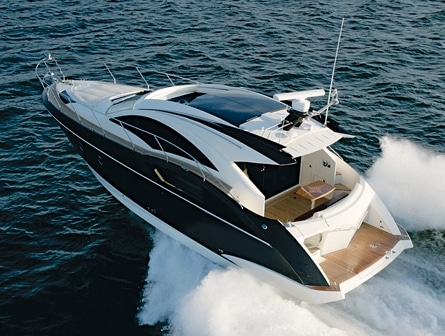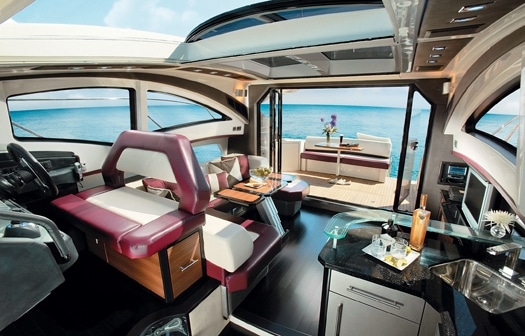
marquis40sc445.jpg
The Riviera has always been known as the place to showoff the biggest and the best. Superyachts rule in Monte Carlo but if you must go smaller then the Riva is the obvious choice. In this tiny kingdom, the favored sandbox of the rich and famous, money and style are everything. So you can imagine my skepticism when I arrived in Monaco to carry out a sea trial on a small American sports cruiser. As I walked along the quay, following in the footsteps of royalty and film stars, I found it difficult to imagine that the Marquis 40 could hold its own in the face of such agressive glamour. I shouldn’t have worried. As I approached, I saw that The Marquis 40 looked right at home.
Despite its American roots, the 40’s strong European influence is no accident. Wisconsin-based Marquis uses Monte Carlo as their international marketing hub and they went to the rising stars of the European design world to develop this new boat. Nuvolari and Lenard from Italy have had a stunning influence on the design of everything from superyachts to production boats and they can now add the Marquis line to their list of winners. In fact, a small crowd was gathered on the dock, gazing admiringly over the row of Rivas at the confident American.
From the outside, the 40 SC is all seductive European curves. The Italian designers have done a great job in creating something that is both stunningly beautiful yet practical. The boat’s flowing lines are enhanced by the metallic granite gray of the hull and by the deck line that rises toward the stern to embrace the lower saloon windows. Above, the deckhouse sweeps upward in a smooth arc that’s supported by the double curvatured glass of the sunroof. And these lines continue aft with a hint of aggression that terminates in sharp mini-fins over the cockpit.
Below, the transom has the same sharp finish, curving outwards in a distinctive line that ends in a sharp point. The design is so thoughtful and balanced that you have to wonder if the interior could possibly meet the same high standards. Inside, the flavor is more American than European, with cream and chocolate paneling bordered by black and maroon trim. The fashionable Zebrano wood furniture adds a touch of texture to a neat and practical saloon. A dark wenge wood deck is on the same level as the teak of the cockpit but separated by a deep sill. Nuvolari and Lenard have done a great job with the rear saloon doors, creating a main access point through a hinged opening door to port but allowing the rest of the glass to be accordioned back. This allows the whole area to be opened up, making the saloon and cockpit one big playroom. When you’re not underway, the transom settee can be moved back electrically, to create even more room in the cockpit.
The saloon table can also be raised and lowered electrically and opens up to provide a larger dining space. The galley is close by, on the forward port side opposite the helm. For a 40-footer, this is a considerable galley with everything you need for sophisticated food preparation. The helm is two steps up on the starboard side with a two-seater bench seat and the wheel in the middle. I am not a big fan of this arrangement-it doesn’t make for comfortable driving in my opinion. Right now side visibility from the helm is poor because of deep supporting struts but these are going to be made smaller on the production models.
The whole saloon is topped by a big glass panel that divides in two when the sunroof section above the helm is opened. This gives nice access to blue skies and the joys of open air cruising. However, the deck levels could be better. Even when standing at the helm there is no view over the windscreen frame-you can only look through the glass. The helm itself is neat and tidy with none of the clutter found on many layouts. Despite a little too much sunlight, it looks good, with the conventional controls you’d expect. The two exceptions are the joystick connected to the Volvo IPS drives and the automatic trim control.

| | |
Down below there is no sense of being crowded. Once again, inspired design is at work. A two berth cabin and the master double forward share a common bathroom, a sensible arrangement that avoids crowding. Corner windows in the edge of the coach roof allow natural light into the master cabin while the twin cabin and the head each have their own skylights.The side decks have handrails in the right places to allow safe passage forward and the teak swim platform is wide enough to stow a jet ski yet still looks appropriate for the length of the boat. In fact, I had to remind myself that this was only a 40-footer-it felt like a much larger vessel in every way.
The version I tested was fitted with top of the line IPS 600 units coupled to a pair of 435- hp Volvo diesels. The joy of IPS for me is that when the drives are combined in the joystick control at the helm, you can position this boat to within inches and just hold it there. The joystick controls let you maneuver like a pro without a lot of thought. And on the Marquis 40, a second joystick is fitted in the stern to allow docking from there. Add Volvo’s automatic interceptor control and half the work of driving the Marquis 40 is done for you. In head seas I still prefer the manual system but the automatic system can’t be beat with beam or following seas and gives a very stable ride.
On our sea trial we ran the Marquis along the coast from Monte Carlo to Cannes, following the classic route for a lunch date on the coast. This was a leisurely cruise with the 420 running comfortably at 28 knots, the sort of speed you felt it could keep up all day.
The sea conditions along this shoreline never seem to be very comfortable-the heavy yacht traffic combined with a fresh breeze often churn up an unpredictable sea. The moderate V-hull, combined with a relatively full bow, make it more sensitive to seas but the ride was still very comfortable. The generous beam ensured good stability. Our speed topped out at 33 knots. Although we were running with a full load fuel, this performance compares well with most sports cruisers.
I have to admit, I fell a little in love with the 440. Its sexy style matches the best on the market but it hasn’t made the mistake of choosing style over substance. The boat is solidly built-it feels good and works well. When European design meets American building, the result is a sports cruiser that can hold its own against a Riva any day.









